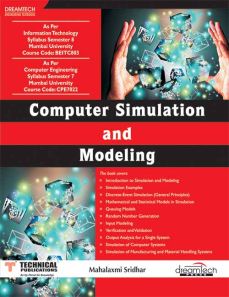Computer Simulation and Modeling
ISBN: 9789351199267
444 pages
For more information write to us at: acadmktg@wiley.com

Description
This book introduces to the world of simulation and modeling. Simulation is the imitation of the operation of a real-world process or system over time. Simulation and modeling help in studying the behavior of a system over a period of time. Simulation also helps in testing a system for its efficiency, accuracy and effectiveness. There are various techniques for simulation, which have been expounded in this book. The book also discusses about simulation on computer system and simulation of manufacturing and material handling system.
Chapter 1: Introduction to Simulation and Modeling
1.1 System Concepts
1.2 Types of Systems
1.3 Model of a System
1.4 Types of Models of a System
1.5 Concepts of Simulation
1.6 Types of Simulation Models
1.7 Application Areas of Simulation
1.8 When Simulation is Appropriate and Not Appropriate
1.9 Advantages and Disadvantages of Simulation
1.10 Steps in a Simulation Study
Chapter 2: Simulation Examples
2.1 Simulation Experiment
2.2 Simulation of a Static System
2.3 Simulation of Dynamic Systems
Chapter 3: Discrete-Event Simulation (General Principles)
3.1 Concepts of Discrete-Event Simulation
3.2 Discrete-Event Simulation
3.3 Event-Scheduling / Time-Advance Algorithm
3.4 World Views on DES
3.5 The Manual Simulation Using Event-Scheduling Approach
3.6 List Processing
Chapter 4: Mathematical and Statistical Models in Simulation
4.1 Why to Use Probability and Statistics for Simulation?
4.2 Review of Terminology and Concepts in Probability and Statistics
4.3 Useful Statistical Models
4.4 Popular Discrete Distributions
4.5 Popular Continuous Distributions
4.6 Empirical Distribution
4.7 Poisson Process
Chapter 5: Queuing Models
5.1 Characteristics of Queuing Systems
5.2 Queuing Notation
5.3 Long-Run Measures of Performance of Queuing Systems
5.4 Steady-State Behavior of Infinite-Population Markovian Models
5.5 Steady-State Behavior of Finite-Population Markovian Models (M/M/c/K/K)
5.6 Networks of Queues
Chapter 6: Random Number Generation
6.1 Properties of Random Numbers
6.2 Pseudo Random Numbers
6.3 Tests for Random Numbers
6.4 Tests for Uniformity
6.5 Tests for Independence
Chapter 7: Random Variate Generation
7.1 Inverse Transform Method
7.2 Inverse Transform Method for Continuous Distribution
7.3 Inverse Transform Method for Discrete Distribution
7.4 Direct Transformation Method
7.5 Convolution Method
7.6 Acceptance-Rejection Method
Chapter 8: Input Modeling
8.1 Input Modeling Approaches
8.2 Steps in the Development of a Useful Model of Input Data
8.3 Data Collection
8.4 Identifying the Distribution with Data
8.5 Parameter Estimation
8.6 Continuous Data in Class Intervals
8.7 Suggested Estimators
8.8 Goodness-of-Fit Tests
8.9 Selecting Input Models without Data
8.10 Covariance and Correlation
8.11 Multivariate Input Models
8.12 Time-Series Input Models
Chapter 9: Verification and Validation
9.1 Terminologies
9.2 Model Building
9.3 Verification of Simulation Models
9.4 Calibration and Validation of Simulation Models
Chapter 10: Output Analysis for a Single System
10.1 Types of Simulations with Respect to Output Analysis
10.2 Stochastic Nature of Output Data
10.3 Measures of Performance and Their Estimation
10.4 Output Analysis of Terminating Simulations
10.5 Output Analysis of Steady-State Simulations
Chapter 11: Simulation of Computer Systems
11.1 Levels of Abstraction in Computer Systems
11.2 Simulation at Computer Network Level
11.3 Simulation at the Computer Subsystem Level
11.4 Simulation at the Combinational / Gate Level
Chapter 12: Simulation of Manufacturing and Material Handling Systems
12.1 Manufacturing and Material Handling Systems
12.2 Goals of Simulations
12.3 Performance Measures of Manufacturing System and Material Handling Systems
12.4 Developing Valid and Credible Simulation Models
12.5 Challenges in Simulation of Complex Systems
Summary
References
Review Exercises
Numerical Problems
Multiple Choice Questions
Descriptive Questions

